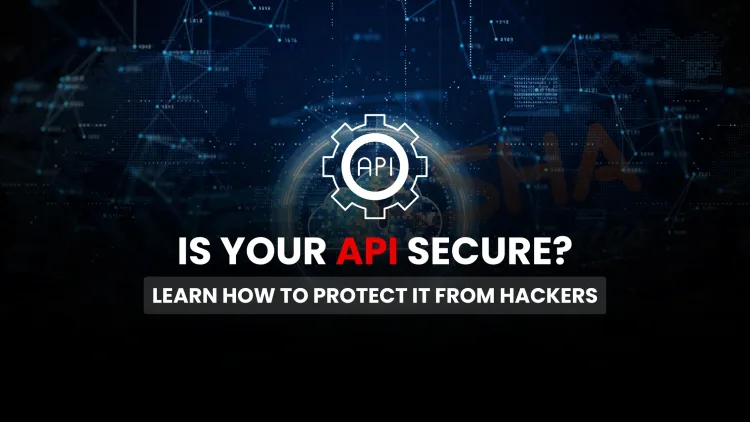Is Your API Really Secure? Discover How to Protect It from Hackers Before They Even Knock
APIs are the backbone of modern applications—but also the #1 target for hackers. Learn how to secure APIs before attackers exploit them using authentication, input validation, rate limiting, gateways, and real-time monitoring. Understand the common attack vectors and top tools to safeguard your data.

Table of Contents
- What Makes APIs So Vulnerable to Attacks?
- Common API Attack Vectors
- Tools Hackers Use to Exploit APIs
- How to Secure APIs Before Hackers Even Knock
- Diagram: Anatomy of an API Attack (Before the Knock)
- Top Open-Source API Security Tools
- Continuous Monitoring = Continuous Security
- Conclusion
- Frequently Asked Questions (FAQs)
APIs are the digital gateways of modern applications — but they’re also prime targets for cybercriminals. From leaking user data to granting unauthorized access, unsecured APIs can bring down entire systems. If you believe your API is secure, it’s time to challenge that belief. In this blog, we explore how hackers exploit APIs, common vulnerabilities, and cutting-edge strategies to secure APIs before attackers strike.
What Makes APIs So Vulnerable to Attacks?
APIs are designed for openness and integration — ironically, that’s also their weakness. Unlike user interfaces, APIs expose internal mechanisms and endpoints that attackers can easily target. Poor coding practices, lack of authentication, and improper rate limiting are just a few gaps hackers exploit.
Real-World Incident: T-Mobile API Breach
In 2023, T-Mobile suffered a major data breach due to an exposed API. Over 37 million records of customer data were accessed without authentication — emphasizing that API security isn’t optional.
Common API Attack Vectors
Understanding how hackers approach APIs is the first step to defense. Below are the most exploited methods:
| Attack Type | Description |
|---|---|
| Broken Object Level Auth | Attackers manipulate object IDs to access data they shouldn’t |
| BOLA (IDOR) | Insecure direct object references leading to unauthorized access |
| Excessive Data Exposure | APIs return too much data in responses |
| Lack of Rate Limiting | Enables brute-force, credential stuffing & DoS attacks |
| Injection Attacks | Malicious input is used to manipulate backend commands (SQLi, Command Injection) |
| Security Misconfigurations | Debug endpoints or verbose error messages leak sensitive data |
Tools Hackers Use to Exploit APIs
Cybercriminals often automate attacks using powerful tools:
-
Postman / Insomnia – For testing API behaviors and crafting malicious requests
-
Burp Suite – Intercepting and manipulating API requests/responses
-
OWASP ZAP – Scanning for vulnerabilities like BOLA or injection flaws
-
Fuzzapi / Wfuzz – Brute-forcing parameters and endpoints
-
Nmap + NSE Scripts – For discovering open API endpoints and server weaknesses
How to Secure APIs Before Hackers Even Knock
1. Implement Robust Authentication & Authorization
-
Use OAuth 2.0, JWT tokens, or API keys
-
Ensure that each user and resource has scoped access
2. Apply Strict Input Validation & Schema Checks
-
Sanitize inputs to avoid injection attacks
-
Use JSON schema validation to restrict input structure
3. Rate Limiting & Throttling
-
Prevent brute-force attacks and abuse
-
Return HTTP 429 (Too Many Requests) on limit violation
4. Enforce HTTPS Everywhere
-
Secure data in transit
-
Prevent man-in-the-middle attacks
5. Avoid Verbose Errors & Debug Logs in Production
-
Never expose stack traces or internal logic
-
Use generic error messages
6. Use API Gateways & Web Application Firewalls (WAF)
-
Filter traffic, block known malicious IPs
-
Enable rate limits, authentication layers, and bot protection
7. Run Continuous API Security Testing
-
Use tools like APIsec, StackHawk, 42Crunch
-
Automate with CI/CD for every API update
Diagram: Anatomy of an API Attack (Before the Knock)
[ Hacker ]
↓
[ Discover exposed endpoint (e.g. /user/123) ]
↓
[ Send manipulated request to /user/124 ]
↓
[ Server fails to check user ownership ]
↓
[ Data exposed: name, email, tokens ]
The hacker never had to "log in" — they knocked on an unlocked door.
Top Open-Source API Security Tools
| Tool | Function |
|---|---|
| OWASP ZAP | Vulnerability scanning |
| Burp Suite | Request interception & fuzzing |
| 42Crunch | CI-based API auditing |
| APIClarity | Observability + security analytics |
| KONG / Tyk | API gateways with built-in protections |
Continuous Monitoring = Continuous Security
Just like DevOps evolved into DevSecOps, API development needs API SecurityOps. Integrate API testing in:
-
GitHub Actions
-
Jenkins pipelines
-
GitLab CI/CD workflows
-
Kubernetes Admission Controllers
Shift left + monitor right.
Conclusion
Most API breaches don’t happen with flashy malware or elite hackers. They happen because of oversights — unsecured endpoints, missing auth, excessive privileges. If you haven’t audited your APIs recently, now is the time.
Don’t wait for a knock. Reinforce your API perimeter before it’s breached.
FAQ
What is API security?
API security is the practice of protecting application programming interfaces from unauthorized access, attacks, and abuse.
Why are APIs targeted by hackers?
APIs often expose backend logic, data, and endpoints that can be exploited if not properly secured.
What is a BOLA attack?
BOLA (Broken Object Level Authorization) allows attackers to access other users' data by changing object IDs in API requests.
How can I secure my REST API?
Use authentication, proper authorization, rate limiting, input validation, and API gateways.
What tools are used for API pentesting?
Common tools include Postman, Burp Suite, OWASP ZAP, APIsec, and 42Crunch.
What is the OWASP API Top 10?
A list of the most common security risks in APIs, including BOLA, data exposure, lack of rate limiting, etc.
What is rate limiting in APIs?
It restricts how many requests a client can make to prevent abuse or DoS attacks.
How do hackers find APIs to exploit?
Through fuzzing, automated scanners, misconfigured endpoints, and leaked documentation.
What is an API token?
An API token is a unique key used to authenticate and authorize API requests.
What is JWT and how is it used in APIs?
JWT (JSON Web Token) is used to securely transmit information between parties in API-based systems.
How do you prevent API injection attacks?
Use input validation, sanitize parameters, and enforce strict content types.
Can HTTPS alone secure my API?
No, HTTPS encrypts data in transit but doesn’t prevent logic flaws or abuse.
What is API fuzzing?
API fuzzing sends random or invalid data to APIs to find vulnerabilities.
What is GraphQL API security?
It involves controlling query depth, rate limiting, and validating inputs to prevent over-fetching and data leaks.
How do you secure API keys?
Store them in environment variables, rotate them frequently, and never expose them in client-side code.
What is an API gateway?
An API gateway manages and secures API traffic by providing rate limiting, authentication, and logging.
What’s the difference between OAuth and API keys?
OAuth provides token-based authorization, while API keys are static strings with limited control.
What is excessive data exposure in APIs?
When APIs return too much unnecessary or sensitive data in responses.
How often should APIs be tested for security?
Regularly, ideally integrated into CI/CD pipelines with automated testing tools.
What are common signs of an API breach?
Unusual traffic, unauthorized data access, missing rate limits, and error message tampering.
How can I monitor API usage?
Use tools like APIClarity, AWS CloudWatch, or custom logging via API gateways.
Are GraphQL APIs more secure than REST?
Not inherently—GraphQL needs strict access control, depth limiting, and validation like REST.
What is a replay attack in API security?
When attackers resend captured legitimate API requests to perform unauthorized actions.
How do you prevent replay attacks in APIs?
Use timestamp validation, nonces, and token expiration checks.
What is HMAC in API security?
Hash-based Message Authentication Code used to verify the integrity and authenticity of API messages.
How do I test my API for security flaws?
Use tools like OWASP ZAP, Burp Suite, Postman, and include security tests in development.
What’s the best way to structure secure API endpoints?
Use RESTful patterns, limit exposure, enforce authentication, and return minimal data.
Should internal APIs be secured?
Yes, even internal APIs should be authenticated, logged, and monitored.
Can APIs be protected with a WAF?
Yes, a Web Application Firewall can filter malicious API traffic and prevent attacks.
What happens if an API is breached?
It can lead to data leaks, unauthorized access, regulatory violations, and reputational damage.












![Top 10 Ethical Hackers in the World [2025]](https://www.webasha.com/blog/uploads/images/202408/image_100x75_66c2f983c207b.webp)


![[2025] Top 100+ VAPT Interview Questions and Answers](https://www.webasha.com/blog/uploads/images/image_100x75_6512b1e4b64f7.jpg)







